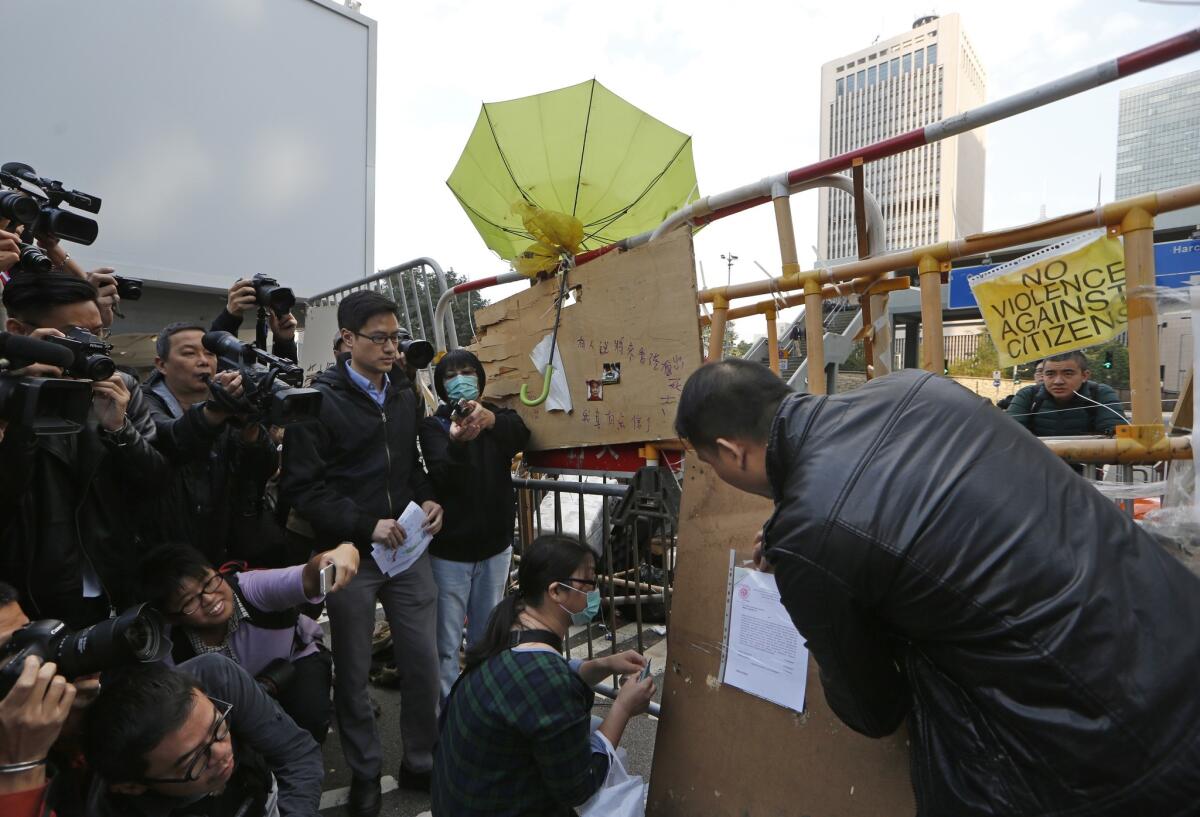Hong Kong police to remove protesters from streets after court order

- Share via
Reporting from Beijing — Setting up what looked to be a final showdown between Hong Kong government authorities and the pro-democracy protesters who have occupied streets for nearly 10 weeks, a court has issued an order allowing for the removal of barricades from areas near government headquarters starting Thursday.
A local bus company obtained the injunction authorizing the clearance operation in the Admiralty district. Notices of the order were published Tuesday and posted in the occupation zone. Thousands of police were reportedly on standby to assist if necessary.
Police indicated they intended to remove all remaining protesters from the streets.
In recent days, the government has hardened its stance after an attempt by protesters last week to besiege the government headquarters was quickly beat back by police in riot gear. With Chinese President Xi Jinping due to visit nearby Macao next week, pressure is mounting for authorities to demolish the encampments once and for all.
At the high point of the movement in mid-October, tens of thousands of demonstrators were blocking major thoroughfares, but since then the crowds have thinned considerably. In late November, police cleared protesters from the Mong Kok neighborhood.
Those who have remained on the streets, however, are among the movement’s most die-hard supporters, and it was unclear whether they would leave their positions peacefully.
“Clearance is tantamount to political suppression, and the police are being used as a political tool,” Alex Chow, secretary-general of the Hong Kong Federation of Students, said Tuesday. “The government might think this is the political solution, yet the political time bomb will still be ticking.”
Hong Kong Chief Executive Leung Chun-ying said Tuesday that “in carrying out police operations, including clearance operations and the removal of barricades, minimal force has been used. And I believe it will be the same in future police operations.”
A person who identified himself as a representative of a shadowy new group called Student Front told local broadcaster RTHK on Tuesday that members of his organization would not rule out meeting whatever level of force the police might deploy with a similar level of resistance “to protect ourselves.”
A yellow-and-black banner reading “We’ll Be Back!” was painted by demonstrators in the Admiralty district Tuesday
Hong Kong, a former British colony of more than 7 million people, returned to Chinese rule in 1997 under a framework known as “one country, two systems” and was promised a high degree of autonomy for 50 years.
Protesters in the territory took to the streets in late September after the Standing Committee of China’s National People’s Congress laid down a tougher-than-expected framework for Hong Kong’s 2017 election for chief executive. The panel essentially decreed that only two or three candidates would be allowed and that all must pass muster with a screening committee.
A two-hour dialogue between protest leaders and five Hong Kong government officials in October yielded no common ground. The session was the first of what was expected to be several rounds of talks aimed at resolving the political crisis, but a second round was never forthcoming. Protesters have sought to pressure the government to revisit the NPC standing committee decision and allow for an open nominations system.
Since then, the government has essentially engaged in a strategy to wait the protesters out, and the movement has appeared to fracture amid a lack of cohesive strategy among various leaders.
Last week, the three main founders of Occupy Central With Peace and Love, the organization that first proposed a civil disobedience movement over the 2017 election rules, surrendered to police in a symbolic move and called on other demonstrators to leave the streets and regroup at a later date.
But their plea has been resisted by many of the high school and college students who make up the core of the movement. The Hong Kong Federation of Students, a leading protest group and the organization that held the dialogue in October with government officials, has yet to accede to a retreat.
Meanwhile, Joshua Wong, the head of another leading student group, Scholarism, briefly engaged in a hunger strike last week but gave up as his health deteriorated. But he has not called for a pullback either.
How the police handle Thursday’s expected operation will be closely watched. In forcibly removing demonstrators from Mong Kok last month, officers used batons and pepper spray and arrested more than 100 people, including Wong.
Many observers believe that officers’ use of tear gas on the initial weekend of protests bolstered public support for the movement, as many citizens believed it constituted an unnecessary use of force against peaceful demonstrators. Seven police officers were later arrested on assault charges after a video surfaced apparently showing them beating a handcuffed protester.
In recent weeks, public support for the street protests -- if not the ultimate democratic aims of the demonstrations -- has diminished, opinion polls show.
But police are also finding their approval ratings are dropping. A survey conducted Nov. 17-19 by Hong Kong University’s Public Opinion Program and released Tuesday found public satisfaction with the territory’s police force has dropped to its lowest point since July 1997, when Hong Kong returned to Chinese sovereignty.
The net satisfaction rate with the force was only 29%, compared with the fire department, which got a 93% rating, the survey of more than 1,000 people found.
Special correspondent Violet Law in Hong Kong contributed to this report.
Follow @JulieMakLAT for news from China
More to Read
Sign up for Essential California
The most important California stories and recommendations in your inbox every morning.
You may occasionally receive promotional content from the Los Angeles Times.











